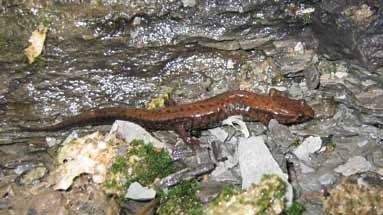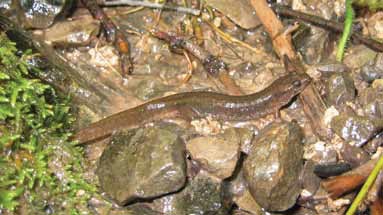Allegheny Mountain Dusky Salamander and Northern Dusky Salamander government response statement
Ontario’s policy direction for the protection and recovery of Allegheny Mountain Dusky Salamander and Northern Dusky Salamander.
Publication date: October 11, 2013


Photos: Rob Tervo
Dusky salamanders are greyish-brown in colour and slender in shape with long tails and hind legs that are larger than their front legs. The Allegheny Mountain Dusky Salamander ranges from 70 to 110 mm in length with a bright yellow to red-coloured dorsal stripe running along it, and a dark brown or black underside. The Northern Dusky Salamander ranges from 60 to 140 mm in length with a uniformly tan or brown dorsal stripe, and a cream-coloured underside.
Protecting and recovering species at risk in Ontario
Species at risk recovery is a key part of protecting Ontario’s biodiversity. Biodiversity – the variety of living organisms on Earth – provides us with clean air and water, food, fibre, medicine and other resources that we need to survive.
The Endangered Species Act, 2007 (ESA) is the Government of Ontario’s legislative commitment to protecting and recovering species at risk and their habitats. As soon as a species is listed as extirpated, endangered or threatened under the ESA, it is automatically protected from harm or harassment. Also, immediately upon listing, the habitats of endangered and threatened species are protected from damage or destruction.
Under the ESA, the Ministry of Natural Resources (the Ministry) must ensure that a recovery strategy is prepared for each species that is listed as endangered or threatened. A recovery strategy provides science-based advice to government on what is required to achieve recovery of a species.
Government response statements
Within nine months after a recovery strategy is prepared, the ESA requires the Ministry to publish a statement summarizing the government’s intended actions and priorities in response to the recovery strategy. The recovery strategy for Allegheny Mountain Dusky Salamander (Desmognathus ochrophaeus) and Northern Dusky Salamander (Desmognathus fuscus) was completed on January 11, 2013 (Allegheny Mountain Dusky Salamander and Northern Dusky Salamander Recovery Strategy).
The response statement is the government’s policy response to the scientific advice provided in the recovery strategy. All recommendations provided in the recovery strategy were considered and this response statement identifies those that are considered to be appropriate and necessary for the protection and recovery of the species. In addition to the strategy, the response statement is based on input from stakeholders, other jurisdictions, Aboriginal communities and members of the public. It reflects the best available traditional, local and scientific knowledge at this time and may be adapted if new information becomes available. In implementing the actions in the response statement, the ESA allows the Ministry to determine what is feasible, taking into account social and economic factors.
Moving forward to protect and recover Allegheny Mountain Dusky Salamander and Northern Dusky Salamander
The Allegheny Mountain Dusky Salamander and Northern Dusky Salamander are listed as endangered species under the ESA, which protects both the animals and their habitat. The ESA prohibits harm or harassment of both species and damage or destruction of their habitat without authorization. Authorization would require that conditions established by the Ministry be met.
The Allegheny Mountain Dusky Salamander is known to occur at two locations in Ontario’s Niagara Gorge, southeast of the town of Queenston. Its range extends from eastern Tennessee through the Appalachian Mountains and along the shores of Lake Erie and Lake Ontario to southern Quebec. Located approximately four kilometres away, the Northern Dusky Salamander’s single known population in Ontario is found among seeps that flow into the Niagara River. The Northern Dusky Salamander’s range is similar to that of the Allegheny Mountain Dusky Salamander, extending from South Carolina through the Northeast United States into southern Quebec. Both species are considered globally secure.
The Allegheny Mountain Dusky Salamander and Northern Dusky Salamander are lungless and rely on their moist skin for respiration. These species inhabitat moist and shaded streams supported by groundwater discharge, which are rare within southern Ontario. As a result, any deterioration, interruption or contamination of the groundwater and surface water that supports the species could potentially have catastrophic effects. As well, loss of ground cover – such as leaf litter, woody debris, rocks and moss that provide shelter and protection from predators and harsh weather – may lead to population declines. Other threats include landslides causing erosion and siltation, the clearing of the forested canopy above the species' habitat, disruption by hikers venturing off trail, the invasive European Common Reed (Phragmites australis ssp. australis), and inbreeding. Based on the information to date, all populations in Ontario are believed to be viable and self-sustaining.
The government’s goal for the recovery of the Allegheny Mountain Dusky Salamander and Northern Dusky Salamander is to maintain suitable habitat conditions in the Niagara Gorge in order to retain existing known populations in a self-sustaining state and promote natural increases.
Protecting and recovering species at risk is a shared responsibility. No single agency or organization has the knowledge, authority or financial resources to protect and recover all of Ontario’s species at risk. Successful recovery requires inter-governmental co-operation and the involvement of many individuals, organizations and communities.
In developing the government response statement, the Ministry considered what actions are feasible for the government to lead directly and what actions are feasible for the government to support its conservation partners to undertake.
Government-led Actions
To help protect and recover the Allegheny Mountain Dusky Salamander and Northern Dusky Salamander the government will directly undertake the following actions:
- Protect and manage the surface water and groundwater system that sustains the seep and stream habitat of the Allegheny Mountain Dusky Salamander and Northern Dusky Salamander through continued water budget assessments that determine the quantity and quality of the water moving within the local area of the Niagara Gorge and any natural or human activities that influence the system.
- Educate other agencies and authorities involved in planning and environmental assessment processes on the protection requirements under the ESA.
- Encourage the submission of Allegheny Mountain Dusky Salamander and Northern Dusky Salamander data to the Ministry’s central repository at the Natural Heritage Information Centre or the Ontario Reptile and Amphibian Atlas.
- Undertake communications and outreach to increase public awareness of species at risk in Ontario.
- Protect the Allegheny Mountain Dusky Salamander and Northern Dusky Salamander and their habitat through the ESA.
- Support conservation, agency, municipal and industry partners, and Aboriginal communities and organizations to undertake activities to protect and recover the Allegheny Mountain Dusky Salamander and Northern Dusky Support will be provided through funding, agreements, permits (including conditions) and/or advisory services.
- Establish and communicate annual priority actions for government support in order to encourage collaboration and reduce duplication of efforts.
Government-supported actions
The government endorses the following actions as being necessary for the protection and recovery of the Allegheny Mountain Dusky Salamander and Northern Dusky Salamander. Actions identified as "high" will be given priority consideration for funding or for authorizations under the ESA. The government will focus its support on these high-priority actions over the next five years.
Focus Area: Research and Monitoring
Objective: Assess and improve knowledge of the species' demographics and physical environment in Ontario.
Actions:
- (High) Develop and implement a standardized survey and monitoring program for the Allegheny Mountain Dusky Salamander and Northern Dusky Salamander and their habitat to:
- conduct searches of suitable unoccupied habitat along the Niagara Escarpment and Fonthill Kame Moraine for undiscovered populations;
- monitor changes in slope stability and erosion rates on hillsides in the species' habitat;
- monitor population levels and trends; and
- monitor genetic health of the populations to detect potential inbreeding.
- (High) Develop an integrated program to measure, forecast, and detect changes in the quantity and quality of water supporting the species' habitat. This includes:
- developing a water budget model;
- characterizing and simulating the surface water and groundwater system and contaminant transport;
- assessing water use and land use scenarios;
- measuring seasonal and yearly averages of the flows of seeps and streams; and
- integrating the monitoring of climate, surface and groundwater within the local area of the Niagara Gorge.
Focus Area: Protection and Management
Objective: Maintain suitable habitat, particularly groundwater quantity and quality, and minimize threats from adjacent land uses.
Actions:
- (High) Work with stakeholders, engineers, and contractors to implement beneficial management practices that minimize impacts on groundwater recharge areas and seeps. Water budget modelling can help to forecast and identify potential impacts caused by changing land and water uses.
- Plant native trees to reduce hillside erosion and deforestation and create stormwater management ponds to capture and slow down run- off of herbicides, pesticides and other pollutants.
- Investigate whether the removal of European Common Reed will improve or negatively impact the quality of the habitat. The European Common Reed eliminates habitat use by the salamanders, but also helps to stabilize the slope and prevent soil erosion. If appropriate, implement the Ministry’s protocol for the control of European Common Reed.
Focus Area: Awareness
Objective: Raise awareness and promote collaboration in the protection and recovery of the Allegheny Mountain Dusky Salamander and Northern Dusky Salamander in Ontario.
Actions:
- Prepare educational materials such as pamphlets to inform park visitors about the endangered status of these salamanders and the need to not disturb them or their habitat, and to discourage off-trail hiking.
Implementing actions
Financial support for the implementation of actions may be available through the Species at Risk Stewardship Fund, Species at Risk Research Fund for Ontario, or the Species at Risk Farm Incentive Program. Conservation partners are encouraged to discuss project proposals related to the actions in this response statement with the Ministry. The Ministry can also advise if any authorizations under the ESA or other legislation may be required to undertake the project.
Implementation of the actions may be subject to changing priorities across the multitude of species at risk, available resources and the capacity of partners to undertake recovery activities. Where appropriate, the implementation of actions for multiple species will be co-ordinated across government response statements.
Reviewing progress
The ESA requires the Ministry to conduct a review of progress towards protecting and recovering a species not later than five years from the publication of this response statement. The review will help identify if adjustments are needed to achieve the protection and recovery of the Allegheny Mountain Dusky Salamander and Northern Dusky Salamander.
Acknowledgement
We would like to thank all those who participated in the development of the "Recovery Strategy for the Allegheny Mountain Dusky Salamander (Desmognathus ochrophaeus) and Northern Dusky Salamander (Desmognathus fuscus) in Ontario" for their dedication to protecting and recovering species at risk.